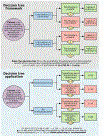Decision analysis and reinforcement learning in surgical decision-making
- PMID: 32540036
- PMCID: PMC7390703
- DOI: 10.1016/j.surg.2020.04.049
Decision analysis and reinforcement learning in surgical decision-making
Abstract
Background: Surgical patients incur preventable harm from cognitive and judgment errors made under time constraints and uncertainty regarding patients' diagnoses and predicted response to treatment. Decision analysis and techniques of reinforcement learning theoretically can mitigate these challenges but are poorly understood and rarely used clinically. This review seeks to promote an understanding of decision analysis and reinforcement learning by describing their use in the context of surgical decision-making.
Methods: Cochrane, EMBASE, and PubMed databases were searched from their inception to June 2019. Included were 41 articles about cognitive and diagnostic errors, decision-making, decision analysis, and machine-learning. The articles were assimilated into relevant categories according to Preferred Reporting Items for Systematic Reviews and Meta-Analyses extension for Scoping Reviews guidelines.
Results: Requirements for time-consuming manual data entry and crude representations of individual patients and clinical context compromise many traditional decision-support tools. Decision analysis methods for calculating probability thresholds can inform population-based recommendations that jointly consider risks, benefits, costs, and patient values but lack precision for individual patient-centered decisions. Reinforcement learning, a machine-learning method that mimics human learning, can use a large set of patient-specific input data to identify actions yielding the greatest probability of achieving a goal. This methodology follows a sequence of events with uncertain conditions, offering potential advantages for personalized, patient-centered decision-making. Clinical application would require secure integration of multiple data sources and attention to ethical considerations regarding liability for errors and individual patient preferences.
Conclusion: Traditional decision-support tools are ill-equipped to accommodate time constraints and uncertainty regarding diagnoses and the predicted response to treatment, both of which often impair surgical decision-making. Decision analysis and reinforcement learning have the potential to play complementary roles in delivering high-value surgical care through sound judgment and optimal decision-making.
Copyright © 2020 Elsevier Inc. All rights reserved.
Conflict of interest statement
Figures





References
-
- Hadley J, Steinberg EP, Feder J. Comparison of uninsured and privately insured hospital patients. Condition on admission, resource use, and outcome. JAMA. 1991;265:374–9. - PubMed
-
- Goldenson RM. The encyclopedia of human behavior; psychology, psychiatry, and mental health. 1st ed Garden City, N.Y.,: Doubleday; 1970.
-
- Dijksterhuis A, Bos MW, Nordgren LF, van Baaren RB. On making the right choice: the deliberation-without-attention effect. Science. 2006;311:1005–7. - PubMed
-
- Bekker HL. Making choices without deliberating. Science. 2006;312:1472; author reply - PubMed
-
- Wolf FM, Gruppen LD, Billi JE. Differential diagnosis and the competing-hypotheses heuristic. A practical approach to judgment under uncertainty and Bayesian probability. JAMA. 1985;253:2858–62. - PubMed
Publication types
MeSH terms
Grants and funding
LinkOut - more resources
Full Text Sources
Other Literature Sources
Medical

